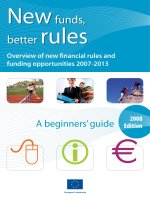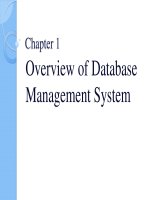Pesonal finance 6th madura chapter 01 overview of a financial plan
Bạn đang xem bản rút gọn của tài liệu. Xem và tải ngay bản đầy đủ của tài liệu tại đây (625.62 KB, 55 trang )
Personal Finance
SIXTH EDITION
Chapter 1
Overview of a Financial
Plan
Copyright © 2017, 2014, 2011 Pearson Education, Inc. All Rights Reserved
Chapter Objective
1.1 Explain how you benefit from personal finance
1.2 Identify the key components of a financial plan
1.3 Explain how financial planning affects your cash flows
1.4 Outline the steps involved in developing your financial plan
Copyright © 2017, 2014, 2011 Pearson Education, Inc. All Rights Reserved
Definitions
•
Personal finance: the process of planning your spending, financing, and investing to
optimize your financial situation
•
Personal financial plan: a plan that specifies your financial goals and describes the
spending, financing, and investing plans that are intended to achieve those goals
•
Opportunity cost: what you give up as a result of a decision
Copyright © 2017, 2014, 2011 Pearson Education, Inc. All Rights Reserved
How You Benefit from an Understanding of Personal Finance
•
Make your own financial decisions
– Every spending decision has an opportunity cost
•
Judge the advice of financial advisors
– Make informed decisions
•
Become a financial advisor
– Many career opportunities available
Copyright © 2017, 2014, 2011 Pearson Education, Inc. All Rights Reserved
Components of a Financial Plan
•
Budgeting and tax planning
•
Managing your liquidity
•
Financing your large purchases
•
Protecting your assets and income (insurance)
•
Investing your money
•
Planning your retirement and estate
Copyright © 2017, 2014, 2011 Pearson Education, Inc. All Rights Reserved
A Plan for Your Budgeting and Tax Planning
•
Budget planning: The process of forecasting future expenses and savings
–
Evaluate your current financial position
Assets: what you own
Liabilities: what you owe
Net worth: the value of what you own minus the value of what you owe
Copyright © 2017, 2014, 2011 Pearson Education, Inc. All Rights Reserved
Budget and Tax Planning
Copyright © 2017, 2014, 2011 Pearson Education, Inc. All Rights Reserved
A Plan to Manage Your Liquidity (1 of 2)
•
Liquidity: access to funds to cover any short-term cash deficiencies
•
Money management: decisions regarding how much money to retain in a liquid form
and how to allocate the funds among short-term investment instruments
Copyright © 2017, 2014, 2011 Pearson Education, Inc. All Rights Reserved
A Plan to Manage Your Liquidity (2 of 2)
•
Credit management: decisions regarding how much credit to obtain to support your
spending and which sources of credit to use
Copyright © 2017, 2014, 2011 Pearson Education, Inc. All Rights Reserved
Managing Your Liquidity
Copyright © 2017, 2014, 2011 Pearson Education, Inc. All Rights Reserved
A Plan for Your Financing
•
Loans often needed for large expenditures
–
College tuition, car, house
–
Managing loans
How much can you afford to borrow?
Determining maturity of the loan
Selecting a loan with a competitive interest rate
Copyright © 2017, 2014, 2011 Pearson Education, Inc. All Rights Reserved
Financing Your Large Purchases
Copyright © 2017, 2014, 2011 Pearson Education, Inc. All Rights Reserved
A Plan for Protecting Your Assets and Income
•
Insurance planning: Determining the types and amount of insurance needed to protect
your assets
–
Automobile and homeowner’s insurance protect assets
–
Health insurance limits potential medical expenses
–
Disability and life insurance protect your income
Copyright © 2017, 2014, 2011 Pearson Education, Inc. All Rights Reserved
A Plan for Your Investing
•
Any funds beyond what you need to maintain liquidity should be invested
–
Primary objective to earn a high return
–
Potential investments include stocks, bonds, mutual funds and real estate
–
Risk: uncertainty surrounding the potential return on an investment
–
Manage investments to keep risk at a tolerable level
Copyright © 2017, 2014, 2011 Pearson Education, Inc. All Rights Reserved
A Plan for Your Retirement and Estate
•
This includes insurance planning, retirement planning, and estate planning
–
Retirement planning: determining how much money should be set aside each year for
retirement and how you should invest those funds
–
Estate planning: determining how your wealth will be distributed before or upon your death
Copyright © 2017, 2014, 2011 Pearson Education, Inc. All Rights Reserved
Building Your Own Financial Plan
•
Enhances your net worth
•
Builds your wealth
•
All components of your financial plan affect your cash inflows and outflows and how
much cash you have available
Copyright © 2017, 2014, 2011 Pearson Education, Inc. All Rights Reserved
How Financial Plan Decisions Affect Your Cash Flows (1 of 13)
•
How the components relate to your cash flows
–
Cash inflows are cash that you receive
–
Cash outflows are cash that you spend
–
Budgeting balances income and spending
–
Liquidity deals with cash excesses or shortages
Copyright © 2017, 2014, 2011 Pearson Education, Inc. All Rights Reserved
How Financial Plan Decisions Affect Your Cash Flows (2 of 13)
•
Part 1 – Tools for Financial Planning College tuition, car, house
–
Budgeting allows you to plan how you will use the cash you receive in a given period
–
How much should you work this month (if your employer allows flexibility)?
Budget decisions determine how much you spend and the amount of your cash outflows each
month
What products or services should you purchase this month?
Copyright © 2017, 2014, 2011 Pearson Education, Inc. All Rights Reserved
How Financial Plan Decisions Affect Your Cash Flows (3 of 13)
Copyright © 2017, 2014, 2011 Pearson Education, Inc. All Rights Reserved
How Financial Plan Decisions Affect Your Cash Flows (4 of 13)
•
Part 2 – Managing Your Liquidity
–
If you have excess cash this month, how much cash should you add to your checking or saving
account?
–
If you have a cash deficiency this month, how much cash should you withdraw from your
checking or savings account?
–
If you have a cash deficiency this month, how much credit should you use from credit cards or
other sources?
Copyright © 2017, 2014, 2011 Pearson Education, Inc. All Rights Reserved
How Financial Plan Decisions Affect Your Cash Flows (5 of 13)
Copyright © 2017, 2014, 2011 Pearson Education, Inc. All Rights Reserved
How Financial Plan Decisions Affect Your Cash Flows (6 of 13)
•
Part 3 – Personal Financing
–
Should you lease a car?
–
Should you borrow money to purchase a car?
–
–
–
–
Should you borrow money to purchase a home?
How much cash will you need to borrow?
How long a period will you need to borrow funds?
What is the ideal source from which you will borrow funds?
Copyright © 2017, 2014, 2011 Pearson Education, Inc. All Rights Reserved
How Financial Plan Decisions Affect Your Cash Flows (7 of 13)
Copyright © 2017, 2014, 2011 Pearson Education, Inc. All Rights Reserved
How Financial Plan Decisions Affect Your Cash Flows (8 of 13)
•
Part 4 – Protecting Your Wealth
–
–
–
What types of insurance do you need?
How much insurance should you purchase to protect your assets?
How much insurance should you purchase to protect your income?
Copyright © 2017, 2014, 2011 Pearson Education, Inc. All Rights Reserved
How Financial Plan Decisions Affect Your Cash Flows (9 of 13)
Copyright © 2017, 2014, 2011 Pearson Education, Inc. All Rights Reserved









